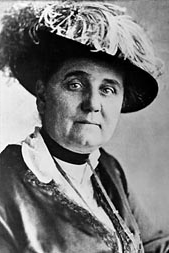September 6: Jane Addams
Jane Addams (1860)
It was on this date, September 6, 1860, that American social reformer Jane Addams, was born in Cedarville, Illinois. Addams graduated valedictorian from the Rockford Female Seminary in 1881. She met and became life-long friends with Ellen Gates Starr,* with whom she traveled in Europe from 1883-1885. There they studied social conditions.
In 1889, Addams and Starr leased a large Italianate style home built two years earlier by Charles Hull at the corner of Halsted and Polk Streets on Chicago's ethnically diverse Near West Side. Their purpose was, "to provide a center for a higher civic and social life; to institute and maintain educational and philanthropic enterprises and to investigate and improve the conditions in the industrial districts of Chicago." Hull-House became, in the words of the Encyclopedia Americana, "the first and most famous settlement house in the United States." On June 23, 1965, it was designated as a U.S. National Historic Landmark.
Modeled on Toynbee Hall, in London's East End, Addams ran Hull-House for the next 46 years. During that time, Addams and Starr traveled, made speeches, raised funds, and wrote books. Addams authored Democracy and Social Ethics (1902) and Twenty Years at Hull-House (1910), The Second Twenty Years at Hull-House (1930) and others. She avoids religion in these works, which was not only politically expedient for her to do - Addams was the aunt of the Marcet Haldeman-Julius, the equally Atheistic wife of publisher E. Haldeman-Julius - but confirms the non-religious philosophy of the social service Hull-House provided to the underprivileged in Chicago.
In the Hull-House area of Chicago Addams led investigations on midwifery, narcotics consumption, milk supplies, and sanitary conditions. She created a music school, a library, an art gallery, a museum, and a theater at Hull-House as part of the struggle against urban poverty. Her own schooling had taught her religion and "good works," but she made Hull-House an institution of good works without religion. Addams successfully kept Hull-House independent of any denominational affiliation. There were Christmas celebrations and such, but without prayer or dogmatism. As Addams said, "Action indeed is the sole medium of expression for ethics."
Along with her Hull-House activities, Addams actively supported the campaign to win voting rights for women and the founding of the National Association for the Advancement of Colored People, while also supporting the American Civil Liberties Union. In 1910, Yale University awarded Addams the first honorary degree it had ever awarded to a woman. In 1915, she accepted the chairmanship of an American organization called the Women's Peace Party, and later the presidency of the International Congress of Women convened at The Hague. Addams was pilloried in the press for opposing America's entry into World War I, but in 1931 she was awarded the Nobel Peace Prize for her efforts, the first American woman to be so honored.
Her nephew, James Weber Linn, in his biography of Jane Addams (1935),** shows that Addams learned her Rationalism from her father and, although she never preached it, she never departed from it. She joined the Congregational Church, says Linn, only "as she might join a labour-union"; that she "did not accept [membership] so much as undergo it."
Addams seemed to expect that government should have a role in elevating its citizens out of poverty. "Private beneficence," she said, "is totally inadequate to deal with the vast numbers of the city's disinherited." After her death, on 21 May 1935 at age 74, much of Chicago turned out to commemorate her high character and unselfish life’s work. Her funeral - in the courtyard of Hull-House - was, by her direction, unsectarian.
* Addams and Starr traveled together in Russia, as well, and met Leo Tolstoy in 1896.
** Jane Addams, by J.W. Linn, 1935, pp. 80-1.
NB: According to news reports in January 2012, Hull House, the Chicago social services organization founded more than 120 years ago by Nobel Peace Prize winner Jane Addams, closed after running out of money.
Originally published September 2003 by Ronald Bruce Meyer.


